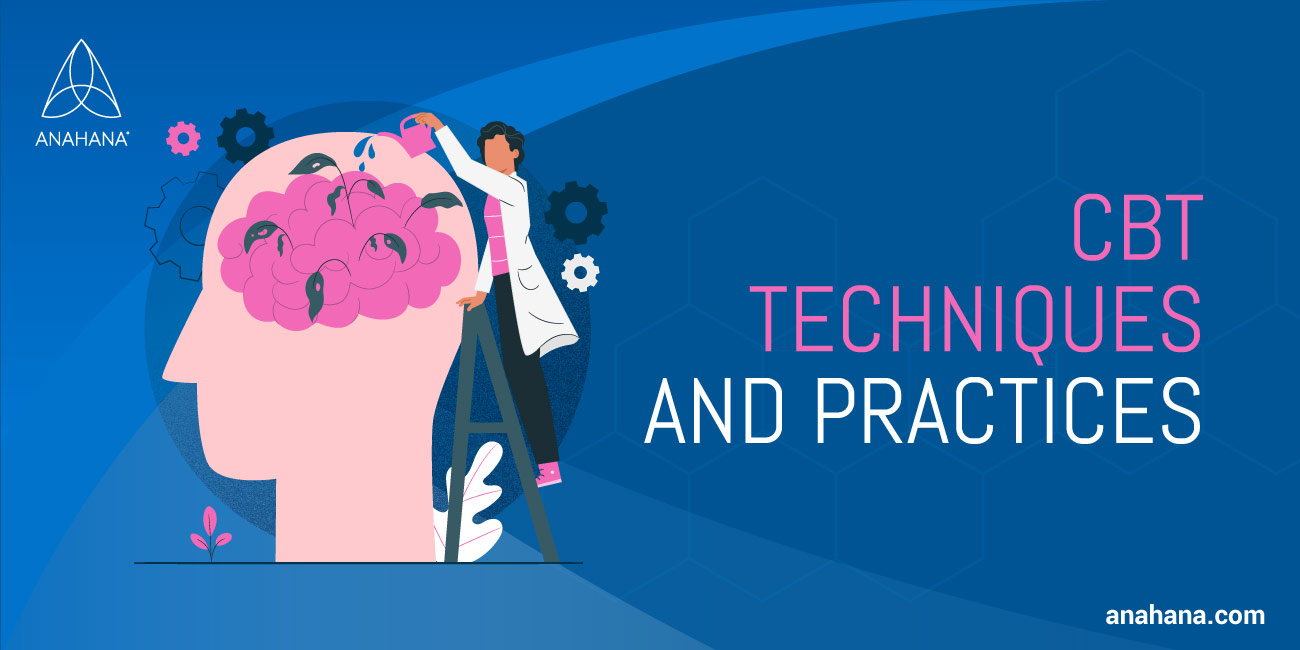
Table of Contents
Cognitive Behavioral Therapy, or CBT, is a type of psychotherapy that helps people identify and change negative thought processes and behaviors. It has become one of the most commonly used therapeutic approaches.
What is Cognitive Behavioral Therapy
CBT is one of the most effective treatments for anxiety, depression, and chronic pain. It is commonly helpful for other mental illnesses, such as eating disorders, substance use disorders, bipolar disorder, Post Traumatic Stress Disorder (PTSD), and Obsessive-Compulsive Disorder (OCD). The idea behind CBT is that since thoughts influence our emotions and behaviors if thought patterns are changed, the result will be a change in feelings and actions.
CBT comprises weekly sessions with a licensed mental health professional, and a complete set typically lasts 12-20 weeks. Even if an individual cannot complete a full set, a few sessions may improve overall mental health and provide necessary coping skills and strategies.
During the first few sessions, cognitive behavioral therapists will help identify negative thoughts and behaviors and work with the client to change them. Cognitive behavioral therapists may also give homework assignments, such as keeping a journal or practicing new skills outside the sessions, to help the client develop coping mechanisms.
Thought Patterns
 Thought patterns refer to how people interpret the world around them and the situations in which they find themselves. They tend to be helpful or harmful. Each person’s thought patterns are unique to them. Identifying unhealthy patterns helps people challenge them and change them into healthier habits. Here are some of the harmful thought patterns that CBT seeks to challenge:
Thought patterns refer to how people interpret the world around them and the situations in which they find themselves. They tend to be helpful or harmful. Each person’s thought patterns are unique to them. Identifying unhealthy patterns helps people challenge them and change them into healthier habits. Here are some of the harmful thought patterns that CBT seeks to challenge:
-
Overgeneralization is when you see a single adverse event as part of a never-ending pattern of defeat. For example, you may have a bad day at work and then conclude that you’re always going to be a failure.
-
All-or-nothing thinking is when you see things in black and white without any shades of gray. For example, you may tell yourself that you're a complete failure if you’re not perfect.
-
The mental filter is when you focus on the negative aspects of a situation and ignore the positive. For example, you may receive feedback at work that’s mostly positive, but you focus on the one negative comment and ignore the rest.
-
Disqualifying the positive is when you dismiss positive experiences by telling yourself they don’t count. For example, you may have a great day but then tell yourself it was just a fluke and that you’ll never be happy.
-
Jumping to conclusions is when you form an opinion or thought without having all the facts. For example, you may see a person staring at you and assume they must be judging you negatively.
-
Magnification/minimization is when you make something seem more important or less important than it is. For example, you may tell yourself that a small mistake you made proves you are a terrible person.
-
Emotional reasoning is when you believe that it must be true because you feel a certain way. For example, you may feel sure you will fail an exam even though there’s no evidence to support that belief.
-
Should statements are when you have rigid rules about how you and others should behave. For example, you may tell yourself that you “should” always be happy or that other people “should” treat you fairly.
-
Labeling is when you assign a negative label to yourself or others. For example, you may call yourself a “loser” because you made one small mistake.
-
Personalization is when you blame yourself for something that is not your fault. For example, you may think that if someone doesn’t like you, it’s because you’re not good enough.
These thought patterns may lead to anxiety disorders, depression, and other mental health conditions. Working with a CBT therapist helps you identify and change these thought patterns to help you react to situations in a healthier way.
Cognitive Behavioral Therapy History
 When asking what cognitive behavioral therapy is, the answer must also consider how it was developed. This form of cognitive therapy was developed in the 1960s by psychiatrist Aaron T. Beck, who noticed that his patients with depression tended to have negative thinking patterns. CBT initially grew out of behavioral therapy, another psychological treatment method focusing on changing behaviors rather than thoughts. However, CBT soon incorporated cognitive techniques, hence the name “cognitive behavioral therapy.”
When asking what cognitive behavioral therapy is, the answer must also consider how it was developed. This form of cognitive therapy was developed in the 1960s by psychiatrist Aaron T. Beck, who noticed that his patients with depression tended to have negative thinking patterns. CBT initially grew out of behavioral therapy, another psychological treatment method focusing on changing behaviors rather than thoughts. However, CBT soon incorporated cognitive techniques, hence the name “cognitive behavioral therapy.”
More recent research has consistently shown CBT to be an effective treatment for anxiety, depression, and other mental health issues. In fact, the National Institute of Mental Health now recommends CBT as a first-line treatment for anxiety, depression, and emotional difficulties. Many health insurance companies in some countries cover CBT as it is considered a cost-effective treatment plan.
How Does Cognitive Behavior Therapy Work?
CBT works by helping clients understand how thoughts and behaviors affect each other. Once you are aware of the patterns in your thinking, you learn to start changing them. For example, if you are prone to negative thinking, CBT can help you learn to recognize and challenge your negative thoughts. This process leads to a change in behavior, leading to the release of negative emotions and improvement in mental health.
As stated before, CBT is usually done weekly for 12-20 weeks with the help of a cognitive behavioral therapist. The number of sessions may vary depending on individual needs and is usually decided by both client and therapist. CBT mainly relies on talk therapy and often includes homework exercises that synergize with the weekly sessions. The practices will vary from person to person, depending on what thoughts and behaviors need to be changed. Some common exercises used in CBT include:
- Identifying negative thoughts and beliefs
- Challenging and changing negative thoughts
- Learning how to relax
- Practicing assertiveness and positive self-talk
- Setting goals and tracking progress
Cognitive behavior therapy can be delivered in person, over the phone, or online. It is done in different settings, as group therapy sessions or individually. Group sessions often involve sharing experiences with others and practicing new skills in a supportive environment. Individual sessions will be more tailored to an individual’s specific needs.
Cognitive Behavioral Therapy Techniques
 Cognitive behavioral therapy exercises are a crucial part of this therapy. These exercises help people identify and change their negative thoughts and behaviors. They often help one’s emotional health and behavior patterns by providing coping skills. Below are some examples of CBT exercises.
Cognitive behavioral therapy exercises are a crucial part of this therapy. These exercises help people identify and change their negative thoughts and behaviors. They often help one’s emotional health and behavior patterns by providing coping skills. Below are some examples of CBT exercises.
Cognitive Restructuring is a CBT exercise that helps people identify and challenge their negative thoughts and unhelpful beliefs. This exercise involves writing down negative thoughts, evaluating the evidence for and against each thought, and generating a more realistic and positive view.
The Behavioral Experiment is a cognitive behavioral therapy exercise that helps people test their negative thoughts. This exercise involves choosing an activity you avoid because of your negative thoughts and then doing this activity while monitoring your thoughts and feelings.
Exposure Therapy is a cognitive behavioral exercise that helps people confront their fears. This exercise involves gradual exposure to the object or situation that causes fear followed by monitoring thoughts and feelings.
Mindfulness is a cognitive behavioral therapy exercise that helps people focus on the present moment. Mindfulness involves paying attention to your thoughts, feelings, and sensations without judgment.
Relaxation Techniques are cognitive behavioral therapy exercises that help people with stress management and anxiety disorders. This exercise involves breathing exercises, progressive muscle relaxation, and visualization.
CBT for Mental Health Conditions
 Since it offers coping strategies and coping mechanisms, CBT is an effective treatment for many mental health disorders, including mood disorders, major depressive disorder, and posttraumatic stress disorder. Here are some of the most common mental health conditions that CBT may effectively treat:
Since it offers coping strategies and coping mechanisms, CBT is an effective treatment for many mental health disorders, including mood disorders, major depressive disorder, and posttraumatic stress disorder. Here are some of the most common mental health conditions that CBT may effectively treat:
Anxiety Disorders
Anxiety is an emotion experienced by many individuals at some point in their lives. However, it may be debilitating when excessive anxiety interferes with daily activities. Research has shown that CBT is among the psychological therapies used to treat various types of anxiety disorders, including panic disorder, social anxiety disorder, and generalized anxiety disorder.
This form of therapy helps people identify and change their negative thoughts and behaviors related to fear and anxiety. Some of the techniques used in CBT for anxiety include exposure therapy, relaxation techniques, and cognitive restructuring.
Depression
Depression is a common mental illness that causes significant distress and impairment in functioning. CBT helps people identify and change their negative thoughts and behaviors related to sadness and despair. Research has shown that CBT effectively treats depression alone and in combination with medication.
Some techniques used in CBT for depression include exposure therapy, behavioral activation, and cognitive restructuring. CBT also helps people to manage their symptoms of depression, such as sleep problems, fatigue, and low motivation.
Substance Use Disorder
Substance use disorder is a serious condition with four primary characteristics: physical dependence, risky use, social problems, and impaired control. It has many physical, psychological, and social consequences. Research has shown that CBT effectively treats substance use disorders, such as alcohol use disorder. CBT might also help people quit smoking.
CBT helps people identify and change their negative thoughts and behaviors related to substance use. CBT might also help people to manage their withdrawal symptoms and cravings. Some techniques used in CBT for substance use disorder include exposure therapy, contingency management, and cognitive restructuring.
Eating Disorders
Eating disorders cause significant distress and impairment in functioning. CBT helps people with eating disorders to identify and change their negative thoughts and behaviors related to food and eating.
Research has shown that CBT effectively treats anorexia nervosa, bulimia nervosa, and binge eating disorders. Some techniques used in CBT for eating disorders include exposure therapy, cognitive restructuring, and interpersonal psychotherapy.
Obsessive-Compulsive Disorder (OCD)
OCD is a severe mental health disorder that causes significant distress and impairment in functioning. Research has shown that CBT effectively treats OCD. Some techniques used in CBT for OCD include exposure therapy, response prevention, and cognitive restructuring.
People Also Ask about Cognitive Behaviour Therapy

What does cognitive behavioral therapy do?
Cognitive behavioral therapy is a type of psychological therapy that helps people identify and change negative thoughts and behaviors. CBT is one of the most effective treatments for anxiety and depression and is also helpful for other mental health issues. Cognitive behavioral interventions help people deal with emotional challenges, emotional disorders, psychological issues, and stress management.
How long do cognitive behavioral therapy sessions last?
Cognitive behavioral therapy typically lasts 12-20 weeks and is usually done in weekly sessions with a therapist. The duration of CBT may be shorter or longer depending on the individual's needs.
What are the goals of cognitive behavioral therapy?
Cognitive behavioral therapy aims to identify and change negative thoughts and behaviors. CBT also involves homework assignments, such as journaling or practicing new skills outside the session.
What is an example of cognitive behavioral therapy?
An example of cognitive behavioral therapy would be working with a therapist to identify negative thoughts and behaviors and then changing those thoughts and behaviors. CBT may also involve homework assignments, such as keeping a journal or practicing new skills outside the session.
What are the five components of cognitive behavior therapy?
The five components of cognitive behavioral therapy are: identifying negative thoughts and behaviors, changing negative thoughts and behaviors, setting goals, doing homework assignments, and practicing new skills.
Can I do cognitive therapy on myself?
A therapist generally uses CBT in weekly sessions. However, you are able to find CBT books, worksheets, and online exercises that teach you techniques used in CBT. In fact, homework exercises are an integral part of CBT, even when done with a professional therapist.
References
Basic Strategies of Cognitive Behavioral Therapy - Psychiatric Clinics
The Efficacy of Cognitive Behavioral Therapy: A Review of Meta-analyses | SpringerLink
Overview - Cognitive behavioural therapy (CBT) - NHS.
What is Cognitive Behavioral Therapy?
Cognitive behavioral therapy - Mayo Clinic
Cognitive behavioral therapy - Wikipedia
Disclaimer
The contents of this article are provided for informational purposes only and are not intended to substitute for professional medical advice, diagnosis, or treatment. It is always recommended to consult with a qualified healthcare provider before making any health-related changes or if you have any questions or concerns about your health. Anahana is not liable for any errors, omissions, or consequences that may occur from using the information provided.

By: Anahana
The Anahana team of researchers, writers, topic experts, and computer scientists come together worldwide to create educational and practical wellbeing articles, courses, and technology. Experienced professionals in mental and physical health, meditation, yoga, pilates, and many other fields collaborate to make complex topics easy to understand. Anahana is also home to specialists in crystals, tarot, angel numbers, astrology, life path numbers, zodiac signs, and horoscopes. By combining evidence-based wellness with spiritual and energetic practices, the team offers clear, trustworthy guidance for both mind-body health and modern spirituality.